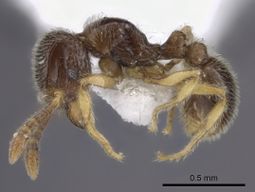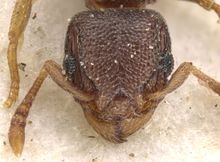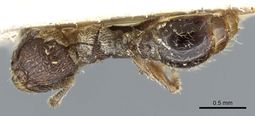Key to Afrotropical Tetramorium ericae osiris inezulae gabonensis species groups
This worker key is based on Bolton (1976)[1]
You may also be interested in
NOTES:
- Tetramorium arnoldi is included in the original key, although it has not branched hairs. It's kept in this key,although does not belong in this group.
- Tetramorium desertorum is known only from the queen caste.
- Tetramorium flabellum belongs to flabellum group, but is better keyed in this group due to its aberrant pilosity
- Tetramorium plumosum belongs to grassii group, but is better keyed in this group due to its aberrant pilosity
- Tetramorium rothschildi is not part of any of these groups but of the T. solidum group, but it was included in the original keys and is kept in this one. Unlike the anterior species, this one possesses branched hairs.
00
- Long hairs on dorsum of mesosoma, pedicel segments and first gastral tergite plumose apically ..... Tetramorium plumosum
- Hairs either simple, bifid, trifid, quadrifid or even more ramified, but always from the insertion, not with a single stem and then plumose apically ..... . . . . . 0
0
- Hairs simple, bifid, trifid or quadrifid..... . . . . . 1
- Hairs dividing in several branches, usually more than seven..... Tetramorium flabellum
1
return to couplet #0
- Antennae with 11 segments. . . . . 2
- Antennae with 12 segments. . . . . 4
2
return to couplet #1
- Dorsum of head and mesosoma finely but distinctly reticulate-rugulose. . . . . 3
- Dorsum of head with a few scattered fine longitudinal rugulae with shining interspaces, mesosoma with fine longitudinal rugulae , not reticulate-rugulose..... Tetramorium antrema
3
return to couplet #2
- Clypeus with a raised transverse carina at the level of the extreme anterior portions of the frontal carinae. The tranverse carinae as strongly developed as the median longitudinal carina which it crosses. Head and mesosoma yellow or yellow-brown..... Tetramorium muscorum
- Clypeus without a raised transverse carina crossing the median longitudinal carinae. Head and mesosoma blackish-brown ..... Tetramorium crypticum
4
return to couplet #1
- With the head in profile the antennal scrobe is either very short and shallow, without a sharp dorsal margin and not divided into upper and lower portions by a longitudinal carina, or is completely absent. The area of the scrobe is generally as strongly sculptured as the remainder of the head and always has hairs arising within the scrobal area. . . . . 5
- With the head in profile the antennal scrobe developed, long and deep, reaching well beyond the posterior margin of the eye and with a sharp dorsal margin. The area of the scrobe less sculptured then the remainder of the head , without hairs arising within the scrobal area and generally divided into upper and lower portions by a medial carina, at least anteriorly. . . . . 7
5
return to couplet #4
- Propodeum unarmed, without spines or teeth ..... Tetramorium agna
- Propodeum armed with a pair of spines or teeth . . . . . 6
6
return to couplet #5
- Anterior border of clypeus broadly and deeply emarginate medially. Basal portion of first gastral tergite finely, closely and densely longitudinally striate. Very large species, HW > 0.95, SL > 0.64) ..... Tetramorium rothschildi
- Anterior border of clypeus transverse, not emarginate medially. Basal portion of first gastral tergite unsculptured or with a few pits from which hairs arise, not densely striate. Smaller species, HW < 0.85, SL < 0.60 ..... Tetramorium eminii
7
return to couplet #4
- Head, mesosoma, pedicel and gaster without branched hairs, all hairs simple and short. Dorsum of mesosoma finely and very densely reticulate-punctate, matt. ..... Tetramorium arnoldi
- At least part of head or body with branched hairs, bifid, trifid or quadrifid; additional simple hairs may be absent or present. Dorsum of alitrunk not densely reticulate-punctate . . . . . 8
8
return to couplet #7
- Dorsal margins of frontal carinae which form the upper borders of the antennal scrobes behind the antennal insertions with a spaced row of elongate simple hairs which are distinctly longer than the surrounding (usually branched) hairs. These long hairs are often erect but in some species are directed laterally; rarely similar long hairs may be present elsewhere on the dorsum of the head also . . . . . 9
- Dorsal margins of frontal carinae which form the upper borders of the antennal scrobes, behind the antennal insertions either without a spaced row of elongate simple hairs or very rarely with a few simple hairs which are very short and do not project above the level of the surrounding branched hairs, not easily seen . . . . . 23
9
return to couplet #8
- Propodeum without spines or teeth, with a pair of minute blunt tubercles which are much shorter than the metapleural lobes . . . . . 10
- Propodeum armed with a pair of spines or acute teeth which are usually longer than the metapleural lobes . . . . . 11
10
return to couplet #9
- Dorsal surfaces of head and mesosoma unsculptured apart from the median carina on the head and a few scattered punctures ..... Tetramorium menkaura
- Dorsal surfaces of head and mesosoma distinctly rugulose ..... Tetramorium imbelle
11
return to couplet #9
- Hairs on anterior (leading) edge of antennal scape of varying length, the longest being simple and at least as long as the maximum width of the scape. If the longest hairs are subequal to the maximum scape width then elongate simple hairs are present on the dorso-lateral pronotal margins which are distinctly longer and more conspicuous than the neighbouring branched hairs .....12
- Hairs on anterior (leading) edge of antennal scape of uniform length and generally branched, all distinctly much shorter than the maximum width of the scape, often less than half the maximum scape width and sometimes closely applied to the surface .....17
12
return to couplet #11
- Strongly bicoloured species: head, gaster and usually also pedicel black; mesosoma, legs, antennae and mandibles clear yellow ..... Tetramorium distinctum
- Either uniformly coloured species or with the gaster somewhat darker than the head and alitrunk, but not bicoloured black and yellow as above. . . . . 13
13
return to couplet #12
- Clypeus with a raised transverse carina at the level of the extreme anterior portions of the frontal carinae, the transverse carina as strongly developed as the median longitudinal clypeal carina which it crosses ..... Tetramorium minimum
- Clypeus without a transverse carina crossing the median longitudinal carina. . . . . 14
14
return to couplet #13
- First gastral tergite basally with a broad belt of coarse punctate sculpture which extends approximately over the basal one-third of the sclerite ..... Tetramorium yarthiellum
- First gastral tergite basally without a belt of punctate sculpture, smooth and shining. . . . . 15
15
return to couplet #14
- Longest hairs on dorsum of head behind clypeus (discounting those on-upper scrobe margins) distinctly shorter than the maximum vertical width of the eye with the head in profile. Small species, HW < 0.50, SL < 0.35 ..... Tetramorium ericae
- Longest hairs on dorsum of head behind clypeus (discounting those on upper scrobe margins) distinctly longer than the maximum vertical width of the eye with the head in profile. Larger species, HW > 0.50, SL > 0.35. . . . . 16
16
return to couplet #15
- Apical halves of mandibles longitudinally striate. First gastral tergite with a mixture of simple and bifid hairs, quadrifid hairs absent. Propodeal spines in profile not downcurved along their length ..... Tetramorium lanuginosum
- Apical halves of mandibles smooth and shining, with scattered small pits. First gastral tergite with hairs predominantly quadrifid. Propodeal spines in profile narrow and slightly downcurved along their length ..... Tetramorium osiris
17
return to couplet #11
- Eyes very small, their maximum diameter distinctly less than the maximum width of the antennal scape ..... Tetramorium microps
- Eyes larger, their maximum diameter at least equal to the maximum width of the antennal scape, usually distinctly greater. . . . . 18
18
return to couplet #17
- Base of first gastral tergite immediately behind the postpetiole with a transverse band of dense and quite coarse punctate sculpture; this area distinctly more coarsely sculptured than the remainder of the tergite. . . . . 19
- Base of first gastral tergite without a band of dense punctate sculpture immediately behind the postpetiole. Usually this area as smooth as the remainder of the tergite but if some faint shagreening is present then the species is large, with SL > 0.50. . . . . 21
19
return to couplet #18
- Hairs on first gastral tergite almost entirely simple, with only one or two bifid or trifid hairs present. Colour uniform pale yellow-brown ..... Tetramorium talpa
- Hairs on first gastral tergite universally branched, bifid, trifid, without simple hairs present. Colour uniform medium to dark brown. . . . . 20
20
return to couplet #19
- Lower portion of antennal scrobe sculptured above the eye. The longitudinal carina which divides the strobe into upper and lower portions indistinct, appearing only as a boundary to or continuation of the sculptured area beneath it. Smaller species, SL 0.34 or less ..... Tetramorium trimeni
- Lower portion of antennal scrobe not or only very faintly sculptured above the eye, the longitudinal carina dividing the strobe into upper and lower portions sharp and distinct. Larger species, SL 0.38 or more ..... Tetramorium inezulae
21
return to couplet #18
- Large species, HW 0.80 or more, SL 0.50 or more, PW 0.60 or more ..... Tetramorium tenebrosum
- Small species, HW < 0.65, SL < 0.45, PW < 0.50 . . . . . 22
22
return to couplet #21
- Full adult colour black or blackish brown. Sculpture of dorsal alitrunk predominantly of quite coarse longitudinal rugulae which may be wavy or meandering ..... Tetramorium furtivum
- Full adult colour yellow or light yellow-brown. Sculpture of dorsal alitrunk a reticulum of fine rugulae, not predominantly longitudinal in direction ..... Tetramorium gestroi
23
return to couplet #8
- Propodeum without spines or teeth, in profile with only a pair of low, minute, obtuse tubercles ..... Tetramorium dedefra
- Propodeum armed with a pair of spines or acute teeth . . . . . 24
24
return to couplet #23
- Head bright golden-yellow; alitrunk, pedicel and gaster blackish brown. Basal one-third to one-half of first gastral tergite with relatively coarse, regular longitudinal striation ..... Tetramorium pulcherrimum
- Unicolourous or the head, gaster or both darker in colour than the alitrunk, never as above. Basal one-third to one-half of first gastral tergite not regularly striate although in some species there is a band of punctate sculpture basally . . . . . 25
25
return to couplet #24
- Anterior (leading) edge of antennal scape with a row of very long simple hairs, the longest of which are distinctly much longer than the maximum width of the antennal scape ..... Tetramorium reptana
- Anterior (leading) edge of antennal scape with short, curved, usually branched hairs which are distinctly shorter than the maximum width of the scape . . . . . 26
26
return to couplet #25
- Branched hairs on dorsal surfaces of head, alitrunk, pedicel and gaster strongly appressed, lying flat or nearly so against the surface of the sclerite from which they arise ..... Tetramorium sericeum
- Branched hairs on dorsal surfaces of head, alitrunk, pedicel and gaster erect or suberect on some or all of these surfaces . . . . . 27
27
return to couplet #26
- Petiole node thickly crescentic in dorsal view ..... Tetramorium monardi
- Petiole node transverse, not crescentic in dorsal view . . . . . 28
28
return to couplet #27
- Branched hairs on disc of first gastral tergite predominantly or universally trifid . . . . . 29
- Branched hairs on disc of first gastral tergite predominantly or universally quadrifid . . . . . 32
29
return to couplet #28
- Lower portion of antennal scrobe below the median carina densely reticulate or rugulose throughout its length ..... Tetramorium baufra
- Lower portion of antennal scrobe below the median carina mostly smooth and shining, not reticulate or rugulose throughout its length . . . . . 30
30
return to couplet #29
- Mandibles smooth and shining with scattered small pits, not striate. Minute species, HW 0.54 at maximum ..... Tetramorium thoth
- Mandibles strongly longitudinally striate. Larger species, HW 0.68 at minimum . . . . . 31
31
return to couplet #30
- Petiole node in dorsal view with its anterior face convex. Larger species, HW ca 0.74 at minimum. Basal portion of first gastral tergite usually with punctures, generally sparse but sometimes coarse ..... Tetramorium brevispinosum
- Petiole node in dorsal view with its anterior face flat and transverse. Smaller species, HW ca 0.68. Basal portion of first gastral tergite unsculptured. ..... Tetramorium surrogatum
32
return to couplet #28
- Median clypeal canna weak or petering out anteriorly. Postpetiole smooth or with only faint traces of sculpture. Larger species, HW 0.90 at minimum, SL 0.68 at minimum ..... Tetramorium gabonense
- Median clypeal carina strongly developed. Postpetiole strongly sculptured. Smaller species, HW 0.84 at maximum, SL 0.54 at maximum ..... Tetramorium constanciae





































































































